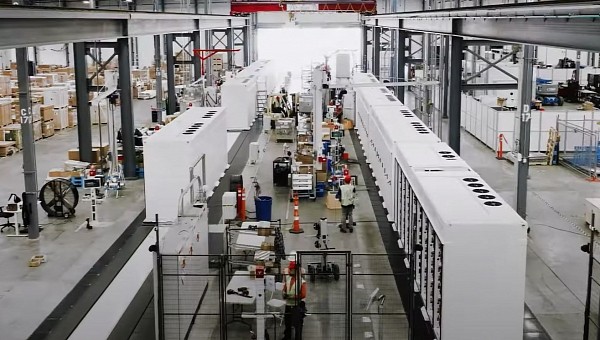Tesla doesn’t plan on giving up on its venture into the utility sector. The latest footage coming out of the Lathrop, California Megafactory is proof that the company is slowly yet surely turning into a key energy player. But the road to success is always under construction.
At the end of 2017, Tesla gave Australians living north of Adelaide and near Jamestown a reason to be more hopeful about their electrical grid’s reliability. The $66 million Hornsdale site needed a little over 6 months to be ready, but, according to an impact study cited by the American EV maker, the facility helped with the saving of around $40 million in under two years. Furthermore, it was connected to a wind farm, so the energy stored in the 100 MWh Powerpack was obtained only from renewable sources. Its mission was to supply energy when the consumption was higher than normal, effectively maintaining the grid stable.
Two years later, Tesla announced the first Megapack. It was a massive battery storage solution that aimed to simplify the deployment of such large-scale projects. One Megapack was able to store up to 3 MWh of electricity and included an inverter capacity of 1.5 MW. This meant it was able to convert DC energy to AC (which is used by the grid) fast and in large amounts. It did what Powerpack could, but better and it was easier to manufacture and install.
Another two years passed, and in 2021 Australia sued the company that used Tesla’s Powerpack system because it became unreliable. However, that didn’t stop the American company from pushing forward.
Just one year later, Tesla updated the Megapack and turned it into the Megapack 2. It stored 50% more energy while weighing 64% more. It also gained some more length and width.
Today, Tesla has the American-made Megapack 2 XL which is almost 20% bigger than the first Megapack. The latest one encompasses the same core thermal components found in the company’s electric vehicles. It’s also easier to deploy than ever and includes a warranty of up to 20 years. Now, each battery has its own inverter, and the entire system can be upgraded remotely. So, safety and versatility have been increased. This energy storage solution’s use cases are many and can easily turn into one of Tesla’s most important products, besides the passenger cars, the Supercharging network, and the Semi.
The world needs more power. Almost everything around us requires electricity. As we move away from fossil fuels and onto renewables, having a backup plan is always welcomed in case there are a couple of windless or cloudy days.
That may be why Tesla decided to give us a look at the Lathrop plant in California where around 10,000 Megapacks can be made per year. If the factory remains open around the clock for 365 days, then it means that the daily output can consist of around 23 Megapacks or more. Considering that one energy storage unit can pack around 3 MWh, it’s amazing to think that Tesla can put out approximately 69 MWh every 24 hours. But it can be even more than that, considering that the company can deliver 40 GWh (40,000 MWh) per year when working at maximum capacity.
However, these baffling numbers can’t become reality without humans. So, Tesla’s hiring. It needs people in manufacturing, engineering, IT, vehicle service, and construction. Care to join them?
Two years later, Tesla announced the first Megapack. It was a massive battery storage solution that aimed to simplify the deployment of such large-scale projects. One Megapack was able to store up to 3 MWh of electricity and included an inverter capacity of 1.5 MW. This meant it was able to convert DC energy to AC (which is used by the grid) fast and in large amounts. It did what Powerpack could, but better and it was easier to manufacture and install.
Another two years passed, and in 2021 Australia sued the company that used Tesla’s Powerpack system because it became unreliable. However, that didn’t stop the American company from pushing forward.
Just one year later, Tesla updated the Megapack and turned it into the Megapack 2. It stored 50% more energy while weighing 64% more. It also gained some more length and width.
Today, Tesla has the American-made Megapack 2 XL which is almost 20% bigger than the first Megapack. The latest one encompasses the same core thermal components found in the company’s electric vehicles. It’s also easier to deploy than ever and includes a warranty of up to 20 years. Now, each battery has its own inverter, and the entire system can be upgraded remotely. So, safety and versatility have been increased. This energy storage solution’s use cases are many and can easily turn into one of Tesla’s most important products, besides the passenger cars, the Supercharging network, and the Semi.
The world needs more power. Almost everything around us requires electricity. As we move away from fossil fuels and onto renewables, having a backup plan is always welcomed in case there are a couple of windless or cloudy days.
That may be why Tesla decided to give us a look at the Lathrop plant in California where around 10,000 Megapacks can be made per year. If the factory remains open around the clock for 365 days, then it means that the daily output can consist of around 23 Megapacks or more. Considering that one energy storage unit can pack around 3 MWh, it’s amazing to think that Tesla can put out approximately 69 MWh every 24 hours. But it can be even more than that, considering that the company can deliver 40 GWh (40,000 MWh) per year when working at maximum capacity.
However, these baffling numbers can’t become reality without humans. So, Tesla’s hiring. It needs people in manufacturing, engineering, IT, vehicle service, and construction. Care to join them?







